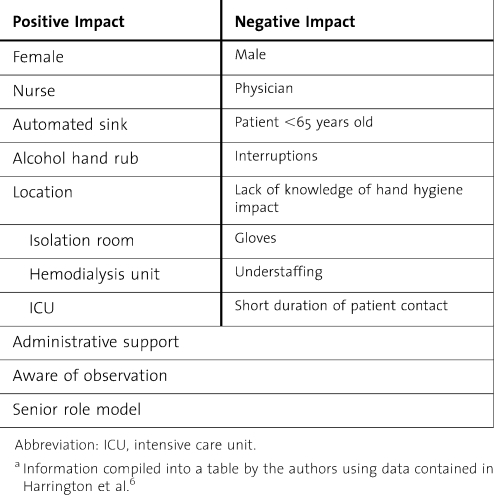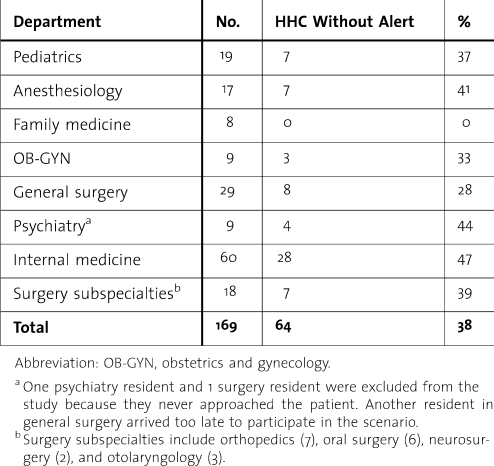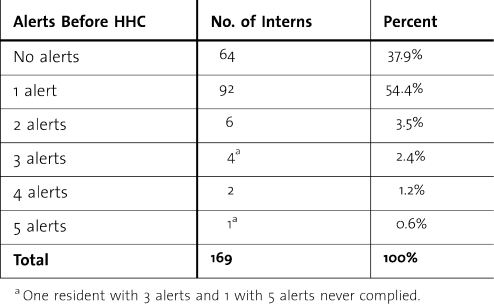Abstract
Background
Residency is a critical transition during which individuals acquire lifelong behaviors important for professionalism and optimal patient care. One behavior is proper hand hygiene (HH), yet poor compliance with accepted HH practices remains a critical issue in many settings. This study explored the factors affecting hand hygiene compliance (HHC) in a diverse group of interns at the beginning of graduate training.
Methods
During a required patient safety course, we observed HH behaviors using a standardized patient encounter. Interns were instructed to perform a focused exam in a simulated inpatient environment with HH products available and clearly visible. Participants were blinded to the HH component of the study. An auditory alert was triggered if participants failed to perform prepatient encounter HH. Compliance rates and the number of alerts were recorded. All encounters were videotaped.
Results
The HHC among the 169 participants was 37.9% pre-encounter and was higher among female interns than males, although this difference was not statistically significant (41.6% versus 31.5%, P = .176). International medical graduates had significantly lower HHC compared with US graduates (23.2% versus 45.1%, P = .006). Most initially noncompliant participants performed HH after 1 alert (87.6%).
Discussion
The initial low rate of HHC in our sample is comparable to other studies. Using direct video surveillance and auditory alarms, we improved our success rates for prepatient encounter HHC. Our study identified medical school origin as an important factor for HHC, and the significantly lower compliance for international medical graduates compared with US graduates has not been previously reported. These findings should be considered in designing interventions such as intern orientation and clinical education programs to improve HH behaviors.
Background
Internship and residency are the primary training and socialization points for new physicians. During this critical transition period, after medical school and at the very outset of residency, lifelong attitudes and behaviors are ingrained around diagnosis, treatment, and interaction with patients and providers. Thus, it is logical to expect that desired practices facilitating outcomes such as systems thinking and a culture of safety should be introduced to and absorbed by new physicians at this time. One such critical behavior is proper hand hygiene (HH).
Health care–acquired infections are rampant, with an estimated 1.7 million cases annually resulting in 99 000 deaths and significant added expenses.1 Improper HH is 1 of the most important contributing factors to health care–acquired infections.2 Despite this information, hand hygiene compliance (HHC) among health care workers in general, and among physicians in particular, is unacceptably low (range, 5%–89%; average, 38.7%).3 table 1 shows several factors that an earlier study found that influence HHC positively or negatively.4 Much effort has been focused on trying to improve HHC in practicing health care professionals, and although there have been some success, sustainable improvement in the rate of HHC is rare.3
Table 1.
Previously Reported Factors Affecting Hand Hygiene Compliancea
By understanding the factors that relate to HHC in a group of recent medical school graduates, we may be able to design targeted interventions during the transition from medical students to attending physicians that may make HHC an automatic behavior for the remainder of their professional careers. The outcomes assessment of the Accreditation Council for Graduate Medical Education anticipates that during the course of their training, residents will develop the necessary knowledge, skills, and attitudes to provide safe and effective patient care.5 Executing proper HHC with each and every patient encounter is 1 of the desired attitudes.
Since 2005, the University of Miami-Jackson Memorial Hospital Center for Patient Safety (CPS) has provided a patient safety curriculum as part of the orientation for all incoming interns. This required course occurs a few days before the start of postgraduate specialty training. The course starts with a 3-hour didactic session from the director of the CPS. Following the lecture and discussion, each intern participates in 3 simulation sessions followed by intensive debriefings. Overseeing these sessions are patient safety professionals (physicians, nurses, and human factors engineers) and faculty from each intern's host department. One of the patient safety goals of the half-day of hands-on simulation training is achieving proper HHC in accordance with established Centers for Disease Control and Prevention guidelines.
The purpose of this study was to evaluate the factors impacting HHC in a diverse group of interns prior to the start of postgraduate training. An understanding of these factors will provide guidance for targeted interventions in medical schools as well as for postgraduate programs to address this important deficiency.
Methods
Interns arrive at the CPS in small groups (usually 6) that typically are from the same specialty program. After registration, the interns provide basic demographic information including their specialty, medical school, and previous exposure to patient safety topics. Interns then participate in 3 simulated scenarios: the first 2 with CPS personnel playing the role of simulated patients and the last with a high-fidelity mannequin. In the first scenario, participants were directed to perform a focused cardiac evaluation (history and physical) on the simulated patient and were informed that they would hand-off the patient to an attending physician. The participants were not told that the scenario also would assess HHC.
On entering an exact replica of a University of Miami Hospital patient room, the intern encountered an actor playing the role of patient. An alcohol-based hand rub dispenser and a sink with soap and paper towels were clearly visible on entry into the room. Disposable gloves also were available and clearly visible. If the intern approached the patient and did not use the alcohol-based hand rub or soap and water, an audible alarm was triggered and the participant heard the following reminder: “Please wash your hands. Please wash your hands.” If the intern did not wash or use the alcohol-based hand rub after 10 seconds, the alert was repeated until HHC was achieved or the time allotted for the scenario ended. At the end of the allotted time, each intern was summoned from the patient room by CPS personnel and escorted to another room to hand-off the patient to an attending physician. Each encounter was archived on videotape for further review.
Although both pre-encounter and postencounter HH is essential, this study was limited to the evaluation of pre-encounter compliance only. The number of HH alerts required for each intern prior to patient contact was recorded. This study was exempted by our Institutional Review Board.
Chi-square analysis was used to test the significance of the differences in HHC between particular subgroups of participants. The significance level was set at 0.05. SAS 9.2 (SAS Inc, Cary, NC) was used for all analyses.
Results
A total of 172 interns were registered to take the patient safety course, and 171 interns were exposed to the clinical scenario to assess HHC (1 intern arrived too late to participate in the scenario). Two of the interns never approached or had contact with the patient or the hospital bed. The alarm was not activated, and they were excluded from the study. The remaining 169 interns were the basis for this HH analysis.
The interns came from every postgraduate program at University of Miami-Jackson Memorial Hospital with the distribution as shown in table 1.
Of the 169 interns, only 64 performed proper prepatient encounter HH without being prompted. Most of the initially noncompliant interns (105) performed HH after 1 alert (92). Eleven interns required multiple alerts before HHC, and 2 interns never performed HH despite the alert having been activated 3 and 5 times, respectively (table 2).
Table 2.
Rate of Hand Hygiene Compliance (HHC) Among Different Departments
The sample included 77 (45.6%) women and 92 (54.4%) men. Without any alerts, 32 (41.6%) of the women were compliant prior to patient contact as compared with 29 (31.52%) of the men (P = .176). table 3 shows the number of alerts before compliance.
Table 3.
Number of Alerts Before Compliance
The sample included 56 (33.1%) international medical schools graduates (IMGs). Thirteen of the 56 IMGs performed proper HH (23.2%) in contrast with 51 of 113 US medical school graduates (45.1%). Thus, there was significantly better HHC among US graduates (P < .006) (table 4).
Table 4.
Hand Hygiene Compliance (HHC) and Medical School Education
Discussion
Before we can seek to effectively improve HHC for health care workers, it is imperative to accurately measure the baseline rate of compliance. Several methods have been used, each with their own strengths and weaknesses.6 Our study used video surveillance to assess HHC without the intern being aware, preventing a Hawthorne effect. Video surveillance is an integral part of the CPS but is neither transferable nor acceptable on clinical care units in the hospital. The interns were not told that we would be measuring HHC.
The clinical scenario used a medically knowledgeable patient actor in an exact replica of a hospital room. We believe that this simulated environment leads to suspension of disbelief and engagement of the participant in the scenario.
The overall rate of appropriate HHC without verbal reminder was 37.9%, comparable with the rate of HHC reported in other studies.3 We found marked variation in the rate of HHC comparing the various specialties. In table 2, the surgery subspecialties (otolaryngology, neurosurgery, orthopedic surgery, and oral surgery) were aggregated because of their small numbers. In general, most departments had a rate close to that reported elsewhere.3
The gender difference in pre-exposure HHC that we observed in this study is consistent with previous studies showing that women exhibit better HHC than men (see table 1).7 However, the small number of participants made statistical analysis of gender distinctions difficult. It could be argued that HHC was lower in our study because of the time pressure imposed by the scenario. However, during residency training, residents will often be pressured for time and yet still must perform proper HHC.8 One of the reasons for the use of alcohol-based hand rubs is to help overcome this barrier. The HHC can be accomplished with the alcohol-based hand rubs while the intern is at the bedside talking to the patient or upon exiting the room, while the intern is walking in the corridor.
No previous studies have related the rate of HHC to medical school origin. Our study found that US medical school graduates had significantly higher rates of HHC compared with IMGs. There may be several explanations for this finding.9 The IMGs in our study are predominantly graduates of Latin American medical schools, and they do not represent all IMGs. Therefore, we cannot extrapolate the findings in this study to IMGs from all geographic regions. In addition, our data do not permit an analysis of an individual's country of origin. It also is possible that graduates of some countries have more exposure to simulation centers and patient safety training than others. Nonetheless, residency program directors should be aware that medical school origin may affect patient safety attitudes and practices as evidenced by HHC.
A variety of interventions have been attempted to improve HHC, including education campaigns for providers and patients, observation and reporting by colleagues, audits and feedback, and visual or auditory alarms.10,11 To date, none of these interventions has achieved satisfactory, sustainable results. Using an approach with direct video surveillance and auditory alarms, we achieved much higher success rates for prepatient encounter HHC than we have been accustomed to seeing. That number (98.1%) may not translate to equally high compliance on the clinical wards. The system we tested in our study is currently being refined for further testing and deployment in clinical units at our institutions. The use of video surveillance would not be appropriate in the clinical setting because of privacy considerations. However, we believe that an alarm system that reminds health care workers to wash their hands will make a positive impact on HHC. Results of the use of the alarm system will be reported in a future article.
Conclusion
Using a voice alert reminder system with a diverse cohort of interns exposed to a standardized clinical scenario in a simulated environment, HHC was ultimately achieved in 98.1% prior to patient exposure. Despite reminders, we found that graduates of non-US medical schools in our training program (primarily from Latin America) may represent another independent risk factor for suboptimal HHC. One explanation may be variability or lack of patient safety training, including the importance of proper HH during their undergraduate medical education. We suggest that internship programs direct attention to HH education for IMGs as a potentially high-risk group for low compliance.
Our study showed that most graduates from international and US medical schools do not appear to have incorporated proper HHC as a routine behavior. Graduate medical education provides an ideal opportunity to reinforce those practices that should have been taught in medical school and are essential behaviors for the practicing physician.
Footnotes
Paul A. Gluck, MD, is Patient Safety Fellow of Anesthesiology at University of Miami Miller School of Medicine; Igal Nevo, MD, is Research Assistant Professor of Anesthesiology at University of Miami Miller School of Medicine; Joshua D. Lenchus, DO, RPh, is Assistant Professor of Medicine and Associate Director of the University of Miami-Jackson Memorial Hospital Center for Patient Safety; Jill S. Sanko, MS, ARNP-BC, is Research and Education Specialist at the University of Miami-Jackson Memorial Hospital Center for Patient Safety; Ruth Everett-Thomas, RN, MSN, is Research and Education Specialist at the University of Miami-Jackson Memorial Hospital Center for Patient Safety; Maureen Fitzpatrick, MSN, ARNP-BC, is Research and Education Specialist at the University of Miami-Jackson Memorial Hospital Center for Patient Safety; Ilya Shekhter, MS, MBA, is Medical Simulation Manager at the University of Miami-Jackson Memorial Hospital Center for Patient Safety; Kristopher L. Arheart, EdD, is Collaborative Biostatistician and Associate Professor of Epidemiology and Public Health at the University of Miami; and David J. Birnbach, MD, MPH, is Professor of Anesthesiology and Public Health at University of Miami and Director of the University of Miami-Jackson Memorial Hospital Center for Patient Safety.
The authors wish to thank Lisa Rosen, MA, Mr Thomas Church, and the staff of the University of Miami-Jackson Memorial Hospital Center for Patient Safety for their assistance with conducting the study and preparing the manuscript.
References
- 1.Klevens M. R., Edwards J. R., Horan T. C., et al. Estimating health care associated infections and deaths in U.S. hospitals, 2002. Public Health Rep. 2007;122(2):160–166. doi: 10.1177/003335490712200205. [DOI] [PMC free article] [PubMed] [Google Scholar]
- 2.Sax H., Allegranzi B., Uckay I., et al. ‘My five moments for hand hygiene’: a user-centered design approach to understand, train, monitor and report hand hygiene. J Hosp Infec. 2007;67(1):9–21. doi: 10.1016/j.jhin.2007.06.004. [DOI] [PubMed] [Google Scholar]
- 3.World Health Organization. WHO guidelines on hand hygiene in health care, 2009. Table 1.16.2. pp. 68–71. Available at: http://whqlibdoc.who.int/publications/2009/9789241597906_eng.pdf. Accessed August 15, 2009.
- 4.World Health Organization. WHO guidelines on hand hygiene in health care, 2009. Table 1.16.3. pp. 72–77. Available at: http://whqlibdoc.who.int/publications/2009/9789241597906_eng.pdf. Accessed August 15, 2009.
- 5.Johnson J. K., Horowitz S. D. Assuring physician competency in patient safety. ACGME Bull. August 2007. pp. 34–35. Available at: http://www.acgme.org/acWebsite/bulletin/bulletin08_07.pdf. Accessed November 5, 2009.
- 6.Harrington L., Lesh K., Doell L., Ward S. K. Reliability and validity of hand hygiene measures. J Healthc Qual. 2007;29(4):20–29. doi: 10.1111/j.1945-1474.2007.tb00201.x. [DOI] [PubMed] [Google Scholar]
- 7.Pittet D. Improving compliance with hand hygiene in hospitals. Infect Control Hosp Epidemiol. 2000;21(6):381–386. doi: 10.1086/501777. [DOI] [PubMed] [Google Scholar]
- 8.Dedrick R. E., Sinkowitz-Cochran R. L., Cunningham C., et al. Hand hygiene practices after brief encounter with patients: an opportunity for prevention. Infect Control Hosp Epidemiol. 2007;28(3):341–347. doi: 10.1086/510789. [DOI] [PubMed] [Google Scholar]
- 9.Cantrell D., Shamriz O., Cohen M. J., et al. Hand hygiene compliance by physicians: marked heterogeneity due to local culture? Am J Infect Control. 2009;37(4):301–305. doi: 10.1016/j.ajic.2008.05.001. [DOI] [PubMed] [Google Scholar]
- 10.Maskerine C., Loeb M. Improving adherence to hand hygiene among health care workers. J Contin Educ Health Prof. 2006;26(3):244–251. doi: 10.1002/chp.77. [DOI] [PubMed] [Google Scholar]
- 11.Boyce J. M., Pittet D. Guideline for hand hygiene in health-care settings: recommendations of the Healthcare Infection Control Practice Advisory Committee and the HICPAC/SHEA/APIC/IDSA Hand Hygiene Task Force. Infect Control Hosp Epidemiol. 2002;23(suppl 12):s3–s40. doi: 10.1086/503164. [DOI] [PubMed] [Google Scholar]






